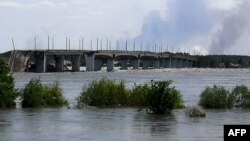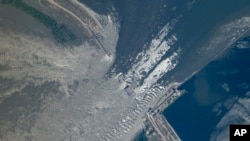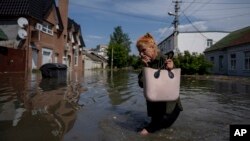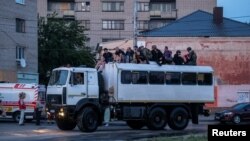Latest developments:
- Britain’s Defense Ministry said Tuesday that during the previous 48 hours, “There has been a substantial increase in fighting along numerous sectors of the front, including those which have been relatively quiet for several months.”
- Ukraine’s ambassador to the Vatican said he hopes a visit from Cardinal Matteo Zuppi, the pope’s peace envoy, will help in "finding appropriate answers" in the name of "just peace."
- The Financial Times cited Serbian President Aleksandar Vucic saying he has no doubt that intermediaries might be providing Serbian ammunition to Ukraine.
Ukraine and Russia accused each other of blowing up a major dam Tuesday near Kherson in southern Ukraine, setting off a new crisis in the war-torn country.
The destruction of the Kakhovka dam in an area of Ukraine occupied by Russian troops unleashed a torrent of water and forced the evacuation of 16,000 people living along the Dnipro River. Ukrainian authorities reported that nearly 40 towns and villages were fully or partially flooded in regions they control, and the impact was also expected to be severe in the Russian-controlled areas.
Looking downstream, Russia controls the left bank of the river and the dam itself, while Ukraine holds the right bank.
In Washington, the White House said it could not say conclusively what caused the destruction of the massive dam but was assessing reports that the blast was caused by Russia, which has been occupying the dam since last year.
National Security Council spokesperson John Kirby said it was clear that the destruction of the dam had likely caused "many deaths."
European Council President Charles Michel said he was “shocked by the unprecedented attack,” tweeting, “The destruction of civilian infrastructure clearly qualifies as a war crime — and we will hold Russia and its proxies accountable.”
At the United Nations, Secretary-General Antonio Guterres said attacks on civilians and civilian infrastructure must stop.
“Today’s tragedy is yet another example of the horrific price of war on people,” he told reporters. “The floodgates of suffering have been overflowing for more than a year. That must stop.”
Both Ukraine and Russia asked the U.N. Security Council to meet in an emergency session, where each blamed the other side for the destruction.
Consequences
U.N. humanitarian chief Martin Griffiths told the meeting that the magnitude of the catastrophe would be fully realized only in the coming days, but it would have “grave and far-reaching consequences” for thousands of people on both sides of the front lines in southern Ukraine who have lost homes, livelihoods and safe drinking water.
“The destruction of the Kakhovka hydroelectric power plant dam is possibly the most significant incident of damage to civilian infrastructure since the start of the Russian invasion of Ukraine in February 2022,” Griffiths told council members.
He reiterated that international humanitarian law protects facilities such as dams, because their destruction can cause severe loss for the civilian population.
Griffiths also expressed concern about the risk of the floodwaters moving landmines or spreading contamination from explosive weapons, further endangering civilians.
The dam supplied water to a swath of southern Ukraine's agricultural territory and the Russian-occupied Crimean Peninsula, as well as cooling the Russian-controlled Zaporizhzhia Nuclear Power Plant (ZNPP).
The Kakhovka reservoir, which is formed by the dam, provides water to cool ZNPP’s reactors and spent fuel pools.
Rafael Grossi, head of the International Atomic Energy Agency, said the reservoir’s water levels had been falling throughout the day Tuesday, but the site has backup options, and there is no immediate risk to the nuclear plant’s safety.
Grossi, who will go to Ukraine next week, said a cooling pond next to the site could provide sufficient water “for some months” and called on all sides in Ukraine to ensure that it “remains intact.”
Russia seized control of the ZNPP early in its full-scale invasion of Ukraine, and Grossi has repeatedly highlighted the potential for a nuclear disaster if the area is not safeguarded.
Evacuations
The Russia-installed administration of Ukraine's Kherson region said it was preparing to evacuate three districts — Nova Kakhovka, Hola Prystan and Oleshky. The latter two lie across the mouth of the Dnipro River from the Ukrainian-held regional capital, Kherson.
Kherson residents said water levels there had already risen by more than a meter and were expected to rise more.
Oleksandr Tolokonnikov, a senior official at Ukraine's Kherson military administration, said flooding would peak on Wednesday.
"We already evacuated about 1,000 people,” Tolokonnikov told reporters. “We have about 50 buses shuttling between Kherson and the affected villages. In Kherson, we have four evacuation sites prepared."
Ukrainian security council
Ukrainian President Volodymyr Zelenskyy on Tuesday called an emergency meeting of his National Security and Defense Council to discuss the situation.
“The destruction of the Kakhovka hydroelectric power plant dam only confirms for the whole world that they must be expelled from every corner of Ukrainian land,” Zelenskyy tweeted, referring to Russian troops. “Not a single meter should be left to them, because they use every meter for terror. It’s only Ukraine's victory that will return security. And this victory will come. The terrorists will not be able to stop Ukraine with water, missiles or anything else.”
The head of Ukraine’s presidential administration, Andriy Yermak, wrote on Telegram that Russia’s destruction of the dam was “ecocide” and a war crime.
Russian officials accused Ukraine of causing an explosion that damaged the dam.
U.N. correspondent Margaret Besheer contributed to this report. Some information came from The Associated Press, Reuters and Agence France-Presse.












